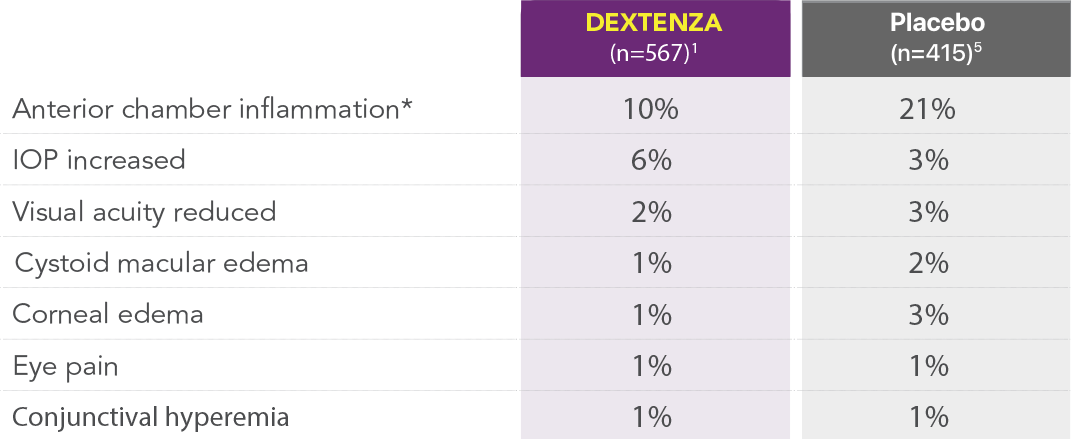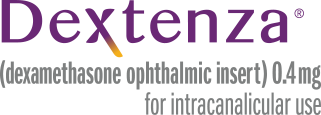OCULAR INFLAMMATION AND PAIN FOLLOWING OPHTHALMIC SURGERY
THREE PIVOTAL PHASE 3 STUDIES IN 926 PATIENTS FOLLOWING OPHTHALMIC SURGERY1-3
Study design2,3
Prospective, U.S. multicenter, randomized 2:1 (Studies 1 and 2) or 1:1 (Study 3), double-masked, parallel-group, vehicle-controlled
Inclusion criteria
- Undergone cataract extraction surgery with intraocular lens implantation
- Potential postoperative pinholed Snellen visual acuity ≥20/200 in both eyes
Exclusion criteria
- Intraocular inflammation
- >0 on the Ocular Pain Assessment; elevated IOP
- Active or chronic/recurrent ocular or systemic disease, inflammatory eye disease, or acute ocular infections
- Punctum <0.4 mm (all studies), ≥1.0 mm (Studies 1 and 2), or >0.9 mm (Study 3)4
Study 1
N=247
DEXTENZA
(n=164)
Placebo
(n=83)
Study 2
N=241
DEXTENZA
(n=161)
Placebo
(n=80)
Study 3
N=438
DEXTENZA
(n=216)
Placebo
(n=222)
Primary Endpoints
- Absence of pain in the study eye at Day 8 (score of 0)
- Absence of anterior chamber cells in the study eye at Day 14 (score of 0)
DEXTENZA patients did not receive
topical NSAIDs as part of post-op care 2,3
Administration of topical anti-inflammation rescue medications was deemed a treatment failure2,3
NSAID = nonsteroidal anti-inflammatory drug
IOP = intraocular pressure
DEXTENZA WAS STUDIED IN THREE PHASE 3 CLINICAL TRIALS1
In each Phase 3 study, more DEXTENZA patients were pain-free at Day 8 and had absent anterior chamber cells at Day 14 vs placebo1-3
- DEXTENZA did not meet the primary endpoint of absence of anterior chamber cells at Day 14 in Study 2
Absence of ocular pain
Patients(%)
Study 1
Study 2
Study 3
Absence of anterior chamber cells
Patients(%)
Study 1
Study 2
Study 3
*Placebo was an insert containing no drug.
†Intent-to-treat population; last observation carried forward.
Fewer DEXTENZA patients required rescue medication vs placebo in the three Phase 3 studies2,3
DEXTENZA WAS WELL TOLERATED1-3, 5
Data pooled from one Phase 2 and three Phase 3 clinical trials
Most common ocular adverse reactions in DEXTENZA patients (≥1%)1,5

*Includes iritis and iridocyclitis.
Most common non-ocular adverse reaction in DEXTENZA patients was headache (1%)1
In the three Phase 3 clinical trials1-3:
- No treatment-related serious adverse reactions
- 1 of 538 DEXTENZA patients (0.2%) discontinued treatment due to an adverse reaction.
- The adverse reaction was not felt by the investigators to be treatment related6
References: 1. DEXTENZA [package insert]. Bedford, MA: Ocular Therapeutix, Inc: 2021. 2. Walters T, et al. J Clin Exp Ophthalmol. 2016;7(4): 1-11. 3. Tyson S, et al. J Cataract Refract Surg. 2019; 45(2):204–212 [erratumin: 2019;45(6):895] 4. Data on File 00823. Ocular Therapeutix, Inc. 5. Data on File 00664. Ocular Therapeutix, Inc. 6. Tyson S, et al. Management of Ocular Inflammation and Pain Following Cataract Surgery with DEXTENZA, Dexamethasone Insert (0.4mg). Poster presented at: 2019 American Society of Cataract and Refractive Surgery Meeting; May, 2019; San Diego, CA.
IMPORTANT SAFETY INFORMATION
CONTRAINDICATIONS
DEXTENZA is contraindicated in patients with active corneal, conjunctival or canalicular infections, including epithelial herpes simplex keratitis (dendritic keratitis), vaccinia, varicella; mycobacterial infections; fungal diseases of the eye, and dacryocystitis.
WARNINGS AND PRECAUTIONS
Intraocular Pressure Increase – Prolonged use of corticosteroids may result in glaucoma with damage to the optic nerve, defects in visual acuity and fields of vision. Steroids should be used with caution in the presence of glaucoma. Intraocular pressure should be monitored during treatment.
Bacterial Infections – Corticosteroids may suppress the host response and thus increase the hazard for secondary ocular infections. In acute purulent conditions, steroids may mask infection and enhance existing infection.
Viral Infections – Use of ocular steroids may prolong the course and may exacerbate the severity of many viral infections of the eye (including herpes simplex).
Fungal Infections – Fungus invasion must be considered in any persistent corneal ulceration where a steroid has been used or is in use. Fungal culture should be taken when appropriate.
Delayed Healing – Use of steroids after cataract surgery may delay healing and increase the incidence of bleb formation.
Other Potential Corticosteroid Complications – The initial prescription and renewal of medication order of DEXTENZA should be made by a physician only after examination of the patient with the aid of magnification, such as slit lamp biomicroscopy, and, where appropriate, fluorescein staining. If signs and symptoms fail to improve after 2 days, the patient should be re-evaluated.
ADVERSE REACTIONS
Ocular Inflammation and Pain Following Ophthalmic Surgery
The most common ocular adverse reactions that occurred in patients treated with DEXTENZA were: anterior chamber inflammation including iritis and iridocyclitis (10%), intraocular pressure increased (6%), visual acuity reduced (2%), cystoid macular edema (1%), corneal edema (1%), eye pain (1%), and conjunctival hyperemia (1%). The most common non-ocular adverse reaction was headache (1%).
Itching Associated with Allergic Conjunctivitis
The most common ocular adverse reactions that occurred in patients treated with DEXTENZA were: intraocular pressure increased (3%), lacrimation increased (1%), eye discharge (1%), and visual acuity reduced (1%). The most common non-ocular adverse reaction was headache (1%).
INDICATIONS
DEXTENZA is a corticosteroid indicated for:
- The treatment of ocular inflammation and pain following
ophthalmic surgery. - The treatment of ocular itching associated with allergic
conjunctivitis.
Please see full Prescribing Information.

